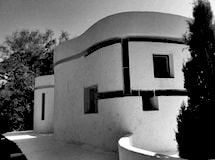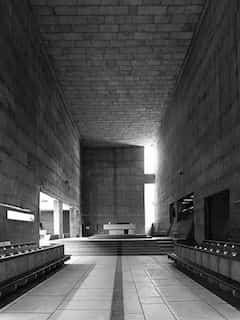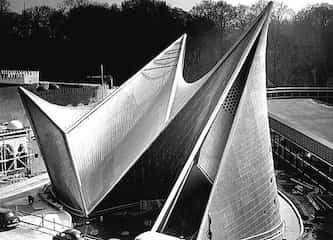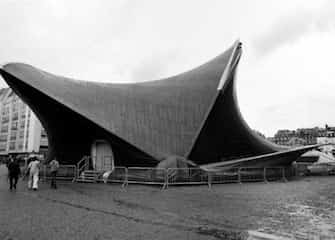Intimate Structures
The Music & Architecture of Iannis Xenakis
by Tom Roseingrave
Iannis Xenakis tends to be remembered as the great composer with the sideline in architecture. Only the brilliant few enjoy a legacy with a selective memory, right? No artist but Xenakis could have had led such a remarkable architectural career – the monastery at La Tourette, the Philips Pavilion, the Polytopes – but for it to be mentioned mostly in passing, an afterthought.
I remember the adverts on the Rome metro for a performance of Xenakis’s Metastaseis (bizarrely wedged between Beethoven and Prokofiev) at the Teatro dell’Opera. Perhaps it was those drab days of January that made me feel like the boy from Joyce’s ‘Araby’. He felt a strange draw after learning of the bazaar from Mangan’s sister; so I wished to hear the music weirdly foretold by the composer with the big printed ‘X’ in his name.
What I remember less clearly is Metastaseis itself. I try, and feel like a child counting from one to twenty: getting to six, saying eleven, and feeling the whole thing fall apart. In my memory there’s no beginning or end. Instead, a spinning force of strings moves in deep ridges and high walls – I try separating the music from the images in my mind and cannot. Why do I remember the music sounding like the orchestra in their semi-circle? Why do I associate Metastaseis with the lines of plasterwork congregating at the centre of the dome above the stalls?
This is hard.

Le Corbusier in his Paris Studio
Between 1947 and 1959, Xenakis worked at the studio of the architect Le Corbusier, where moving between music and architecture was a daily commute. This implies translation – a rendering of the same ideas in a different language. Yet this is not as straightforward as it seems. Architecture unfolds in space and music unfolds in time: if Xenakis understood both forms under the same logic, does translation happen at all?
Xenakis didn’t force architecture and music together - instead, he exposed their proximity.
Here’s the basic distinction: music is perceived by the ear, and architecture by the eye. But boundaries, as we know well by now, are usually more than a little fluid. Musical notation makes the audible visible, just as ‘architecture’ is used in describing non-visual structures - software security programmes, for instance, or non-organic alien life-forms. Then there are the technical terms used across both forms - rhythm, proportion, scale, colour, depth.
In Vitruvius’s De Architectura (written between 30 - 15 B.C.), we can trace the architectural tradition of the merging of media back to the ancients. Vitruvius called for the architect to be knowledgeable in music and philosophy, among other things: ‘for in the architectural judgement all of the work of other arts is brought into test.’ For Xenakis, then, the true artist should be an ‘artist-conceptor’, a polymath inventive in ‘mathematics, logic, chemistry, biology, genetics, paleontology, the human sciences and history; in short a sort of universality, but one based upon, guided by and oriented toward forms and architectures.’
Let’s at least agree on the starting point for Xenakis’s music and architecture. It’s the sort of Nature (the capital N is intentional) which causes meteors to crash and tectonic plates to shift: Nature the Grand Force At Work in the Universe. And in the abstraction of this interpretation of nature into art, Xenakis believed he had the power, as he wrote in the opening sentence of Musiques Formelles (1963), to reveal a truth not made of ‘objects, emotions or sensations,’ but beyond these earthly forms. The ‘artist-conceptor’ reveals him/herself as the ultimate imitator: through knowledge of the universe and its fundamental properties of mathematics and geometry, the artist might reveal a universal truth.
So maybe Metastaseis and my memory of its performance that night is a kind of fleeting truth. Why not? Nature is just as disordered and irrational as my powers of recall.
But the logic that links music and architecture (and more presciently art to nature) is not obvious at first sight, and it’s a good place to start. If I’d leaped from the balcony of the Teatro dell’Opera back in January, the ‘sound surfaces’ of Xenakis’s strings wouldn’t have broken my fall.




